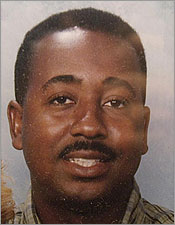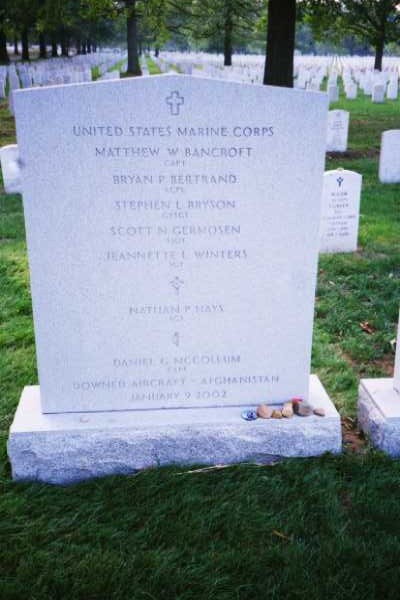U.S. Department of Defense
Office of the Assistant Secretary of Defense (Public Affairs)
News Release
IMMEDIATE RELEASE No. 014-02
January 09, 2002
DOD IDENTIFIES SEVEN MARINES KILLED IN KC-130/R CRASH
The Department of Defense announced that the following Marines were killed as a result of the crash of a KC-130/R aircraft in Pakistan today:
- Command Pilot: Captain Matthew W. Bancroft, 29, of Shasta, California. He joined the Marine Corps in 1994.
- Co-Pilot: Captain Daniel G. McCollum, 29, of Richland, South Carolina He joined the Marine Corps in 1993.
- Flight Engineer: Gunnery Sergeant Stephen L. Bryson, 35, of Montgomery, Alabama. He joined the Marine Corps in 1983.
- Loadmaster: Staff Sergeant Scott N. Germosen, 37, of Queens, New York. He joined the Marine Corps in 1982.
- Flight Mechanic: Sergeant Nathan P. Hays, 21, of Lincoln, Washington. He joined the Marine Corps in 1999.
- Flight Navigator: Lance Corporal Bryan P. Bertrand, 23, of Coos Bay, Oregon. He joined the Marine Corps in 1998.
- Radio Operator: Sergeant Jeannette L. Winters, 25, of Du Page, Illinois. She joined the Marine Corps in 1997.
The Marines are assigned to Marine Aerial Refueler Transport Squadron 352 (VMGR-352), the “Raiders.” Elements of VMGR-352 are attached to Combined Task Force 58, in support of Operation Enduring Freedom. VMGR-352 is home-based at the Marine Corps Air Station, Miramar, California.
The cause of the crash is under investigation.
MONTGOMERY, Alabama — A woman whose sondied with six other Marines in a military plane crash in Pakistan said Thursday shesupports the nation’s fight against terrorism, despite her personal grief.
“The United States is doing the right thing,” said Deloris Bryson, “but I was not prepared to sacrifice my only child.”
Gunnery Sergeant Stephen L. Bryson, 36, a native of Montgomery, died Wednesday when his tanker plane crashed into a mountain ridge. Stationed at the Marine Corps Air Station in Miramar, California, Bryson was married to Katrina Washington, also of Montgomery.
They were wed in 1994 and had no children, family members said.
His father, Jimmie Bryson Jr., is a retired chief master sergeant living in Las Vegas, Nevada, whose brother, Raymond Ervine Bryson, died in the 1984 crash of an Air Force F-4 fighter jet in Marion County, Alabama, while serving in the Mississippi National Guard.
“I could not believe it,” said Bryson’s grandfather, 77-year-old Jimmy Bryson, “our family lost another son in a plane crash.”
“My son loved to fly,” Mrs. Bryson said, “and decided he would make military life his career when he volunteered to join the Marine Corps after graduating from high school.”
She said her son, a graduate of Robert E. Lee High, had called her this week. “He just called to let me know he was thinking about me on Tuesday. It was his birthday. He turned 36.”
She said she had not been told exactly where he was assigned when he was sent overseas.
She said she had spoken to him on Christmas Day and he assured her that he would come home soon.
“I felt something was terribly wrong when I heard about the crash while at work Wednesday afternoon,” she said. “When I arrived home later in the day, my neighbor informed me that two Marine Corps officers had stopped at the house.
“I knew something had happened to Stephen.”
Publication date: 20 June 2002
SAN DIEGO — Human error likely caused the January crash of a refueling plane over Pakistan in which seven San Diego-based Marines were killed, according to a report released Wednesday.
The January 9, 2002, accident was the deadliest crash involving American forces during the U.S.-led effort to eradicate Osama bin Laden’s terrorist network.
Investigators found that the KC-130 flight crew likely became disoriented while attempting a night landing in difficult conditions at an airfield in southwestern Pakistan, where the plane slammed into a mountainside, a review by the Marine Corps concluded.
“The most likely cause of this mishap was that the aircrew … flew too far away from the field at too low an altitude,” according to a summary of the review.
The KC-130 was approaching Bardari airfield near the village of Shamsi about 8 p.m. local time when it was redirected to take a different approach because the military wanted to reduce jet noise over the town and helicopters were parked too close to the landing strip.
Witnesses said they saw the plane circle twice in attempting to land before it crashed and exploded at an altitude of 3,800 feet. If they had gained another 200 feet, they would have cleared the mountain, officials said.
Aircraft at Shamsi must maintain an altitude of 7,000 feet for maneuvering and 5,600 feet to commence a landing attempt.
Colonel Randolph Alles, commanding officer of the Marine unit that includes the KC-130 squadron, said it’s possible the crew was flying at the lower altitude because they were attempting a visual landing, but authorities aren’t sure.
The crew had no night-vision equipment.
“They thought they were clear of the terrain,” Alles said. “There was obviously a mistake in a high-demand environment.”
Weather conditions were good that night but there was no moonlight and the crew had only the lights along the airstrip to guide them, according to investigators.
“It was not LAX,” investigator Colonel William Durrett said, comparing the remote airstrip to Los Angeles International Airport.
Four people on the flight deck — the pilot, co-pilot, navigator and flight engineer — had “collective responsibility” for maintaining a safe altitude, Alles said.
Pakistan had agreed in October to allow U.S. forces to use the base, located 50 miles from the Afghanistan border, as a forward staging area.
Since the crash, the Marine Corps has begun retrofitting three KC-130s with night-vision landing equipment and has plans to do the same to 10 more. The report also recommended upgrading the navigation system on the aircraft.
While the modifications would have helped the crew, “neither would have necessarily prevented the mishap,” the report concluded.
The squadron’s commanding officer, Lieutenant Colonel Carl Parker, said the finding of human error was “a bitter pill” for members of the squadron and families of the victims.
He said it was “safe to say” there was disbelief and anger among some family members.
Investigators acknowledged that the crew was experienced and well-trained, but operating under difficult conditions.
“All of the aircrew were at the top of their field,” said Colonel William Durrett, part of the investigation team.
The crew of seven from Marine Corps Air Station Miramar in San Diego provided supply and aerial refueling support to the war effort.
The victims included Sergeant Jeanette L. Winters, 25, of Gary, Indiana, the first female military casualty in the Afghanistan campaign.
Also killed were Captain Matthew W. Bancroft of Redding; Gunnery Sergeant Stephen L. Bryson of Montgomery, Alabama; Lance Corporal Bryan P. Bertrand of Coos Bay, Oregon; Staff Sergeant Scott Germosen of New York; Sergeant Nathan P. Hays of Wilbur, Washington; and Captain Daniel G. McCollum of Irmo, South Carolina.
BRYSON, STEPHEN LAMON
GYSGT US MARINE CORPS
- VETERAN SERVICE DATES: 06/18/1984 – 01/09/2002
- DATE OF BIRTH: 01/08/1966
- DATE OF DEATH: 01/09/2002
- DATE OF INTERMENT: 03/12/2002
- BURIED AT: SECTION 60 SITE 8015
Michael Robert Patterson was born in Arlington and is the son of a former officer of the US Army. So it was no wonder that sooner or later his interests drew him to American history and especially to American military history. Many of his articles can be found on renowned portals like the New York Times, Washingtonpost or Wikipedia.
Reviewed by: Michael Howard


